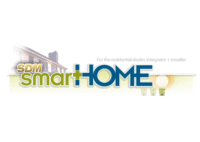Forget Verizons iPhone Deal, Carrier Takes Aim at Home Monitoring, Controls

Now in a “pilot” phase in New Jersey, with plans to roll out nationwide by mid-year, Verizon Communications is tip-toeing into the so-called connected home arena with a home monitoring and control service boasting “anytime, anywhere access to lights, thermostats, appliances and monitoring systems,” via smartphones, computers and its FiOS platform.
With partners that include 4Home, a division of Motorola Mobility, and Ingersoll Rand’s Schlage for LiNK and Trane HVAC, the service, which according to an interview with Verizon spokesperson Alberto Canal can range from do-it-yourself (DIY) to professionally installed, will enable customers to lock doors remotely; see what’s going on at home via networked cameras; and set, adjust and control lights, smart thermostats and appliances.
The Verizon announcement was made late last December. The service was showcased at the January 2011 Consumer Electronics Show (CES) in but was overshadowed by Verizon’s deal with Apple to carry the iPhone beyond AT&T’s long-time agreement with Apple. Separately, a Verizon connected home partner, Ingersoll Rand, was making its own news at CES.
For instance, Schlage demonstrated new capabilities of its LiNK remote home management system for homeowners to monitor and control Z-Wave-enabled locks, lights, Trane thermostats, Schlage cameras and other Z-Wave devices from mobile phones, including iPhone, BlackBerry® and Android™ phones or a computer connected to the Internet. In addition, Ingersoll Rand’s Trane ComfortLink II thermostat, a 7-inch interactive high-definition color touchscreen, enables homeowners to program as much information as they want to see on their thermostat, including the status of their indoor air quality, humidity and individual room temperatures.
Verizon joins broadband service providers such as Xfinity from Comcast and Time Warner as well as security traditionalists ADT Pulse, Protection One eSecure, Alarm.com’s emPower and others in offering different levels of home monitoring services. However, lacking in the Verizon offering is alarm monitoring, a potential misstep, according to Bill Ablondi, a researcher and analyst at Parks Associates. Ablondi also questions the efficacy of using Verizon’s technology in DIY projects involving at times complex setup of home energy management.
When it comes to installation beyond DIY of Verizon’s connected home offerings, “we intend to use local installation professionals,” says Canal. In Xfinity’s pilot, Comcast will first use internal expertise thanks to its acquisition of the local Time Warner operation. Time Warner has been offering alarm monitoring for a number of years and still is in selected regions of the country. In Xfinity’s rollout, it seems likely that it will have to go to others for installation if it intends to roll out its offering more fully and widely. ADT Pulse and Protection One eSecure, as compared, have the advantage of their own home security installation workforce.
Home energy controls seem to be a major “sweet spot” in lifestyle monitoring.
"Consumers are starting to see energy-efficient products and services as a means to improve their home and personal comfort as well as for cost savings, which opens the market for a variety of solutions from utilities, service providers, and manufacturers," adds Ablondi.
No doubt, broadband, wired and wireless service providers are suddenly itching to jump into home monitoring and control; and, thanks to smart appliance and smart grid advances, electric utilities may not be far behind. “It’s all a matter of revenue generating units,” points out Ablondi. While home alarm monitoring revenues have inched up, primarily due to higher monthly fees and some add-ons, the percentage of security monitored homes has slipped. Firms with cable and DSL broadband or wireless mobile into homes and homeowner hands now see ways to create additional one-time and recurring revenue by bundling more services for their current customers and to grab business away from competitors. And these new players into monitored home services have huge muscles.
|
U.S. Households: Penetration of Cable |
|
|
|
Sept. 2010
|
|
Basic Video Customers |
60.4 million |
|
Digital Video Customers |
44.4 million |
|
High Speed Internet Customers (includes commercial) |
43.8 million
|
|
Cable Phone Customers |
23.5 million |
Source: National Cable & Telecommunications Association
|
U.S. Households: Penetration of Wireless
|
|
|
|
June 2010
|
|
Wireless Subscriber Connections |
292.8 million |
|
Percent of Total Population |
93% |
|
Wireless-Only Households |
24.5% |
Source: CTIA
However, there’s a major rub for these big guys, according to Ablondi. Tacking more services on the cable or wireless bill may lead to “sticker shock beyond the already high price of bundling television, voice over IP and wireless.” On the other hand, says the Park Associates analyst, “one day soon a wireless smartphone may be the universal home systems controller, too.”
Verizon’s Canal says that pilot program homes in New Jersey will be outfitted with an energy reader, smart appliance switches and thermostats, a smart power strip, smart door and window locks, motion sensors, an advanced pan-and-tilt camera, and a fixed indoor and outdoor camera. The service runs on Verizon’s FiOS platform, a bundled communications (Internet, telephone, and TV) service operating over a fiber optic communications network that is presently offered in some areas of the . Limited coverage may limit any aggressive nationwide roll-out plans. At present, consumers can choose from various FiOS Internet downstream and upstream options including 15/5 Mbps, 25/25 Mbps, 35/35 Mbps and 50/20 Mbps. Earlier this year, the company began offering 150/35 Mbps Internet service, the fastest speeds available on a mass scale, it claims. In addition, Verizon has a 4G LTE wireless network, in which that technology is expected to continue to enlarge the wireless communications pipeline.
There is some irony in Verizon’s move into home monitoring. The firm is the result of a merger of Bell Atlantic Corp., what many at that time called a Regional Bell Operating Company or RBOC, and GTE Corp. During the days of the AT&T Consent Decree, which effectively broke apart the company into regional companies, and the culmination of the federal Telecommunications Act of 1996, the traditional alarm industry sought and was given relief – delayed entry of the RBOCs into alarm monitoring for five years.
Also late last year, AT&T, a fierce Comcast competitor with its own U-verse home bundles, acquired Xanboo, a long-time home automation player and partner with AT&T over the years. Xanboo technology allows homeowners to monitor security, energy consumption, and digital media across devices.
Whatever the new faces entering home monitoring and no matter from what direction they come in, “IP-based services or what some call cloud-based services can be disruptive technologies,” contends Ablondi. He suggests that security dealers, installers and electronic home systems contractors who understand and embrace the advances will be better for it. Most of these firms are closer to their customers and do not have the “negative baggage” that cable firms, wired and wireless carriers may have to carry into the next world of connected homes.
ADT and its Pulse interactive service seem to underline the advantage of alarm monitoring firms moving successfully into the connected home area. Says Bob Tucker, director, public relations for ADT Security Services, “For decades, customers have desired the ‘peace of mind’ protection provided by 24/7 monitoring. Now, they want all that, but ‘added value’ through additional functionality provided by ADT Pulse. It’s protecting and connecting. It’s life safety and lifestyle. It’s a way for us to grow market share and engage the types of customers who may not have considered us in the past.”
Protection One, the second-largest alarm monitoring firm in the SDM 100, also provides significant lifestyle services through its eSecure, which Doug Paul, the firm’s vice president of operations and corporate services, sees as providing valuable “information and controls.” A homeowner can arm and disarm remotely; receive alerts relative to such issues as the home’s environment, a child arriving home, the condition of elderly at home, the status of pets, and live video look-in as well as video clips, among other services. With asset protection sensors, the homeowner can be notified immediately if a medicine cabinet, gun safe, or another sensitive asset is moved or opened.
Through eSecure, “there is [customer] appeal to know what is going on in the home,” adds Paul. eSecure is a branded version of Honeywell’s Total Connect interactive services as provided by Protection One. Later this year, more home devices equipped with Z-Wave technology will be available through the Protection One gateway; and outdoor cameras will be added to the present indoor IP video offerings.
Other security firms see value in expanding beyond monitored burglar alarms in specific ways. One example: APX Alarm Security Solutions, the security and home services company, recently acquired Meter Solutions, an independent installation provider of smart meter technologies. The acquisition broadens APX's focus on providing smart grid and energy management solutions for consumers. Meter Solutions specializes in the installation of automated metering infrastructure systems or AMI, a technology that automatically collects data from water, gas or electronic meters and wirelessly transmits the information to a central database used for billing and analyzing. This instant data collection provides utility companies with more accurate billing and also reduces labor costs, eliminating the need for additional field technicians and door-to-door meter reading.
"We are excited to see the evolution of home automation and smart grid technologies as they begin to work hand-in-hand," says Alex Dunn, chief operating officer of APX Alarm.
Beyond the gadgets and gizmos inherent in new-age home monitoring, fully featured home security systems play a natural, maybe essential, role since — through arming and disarming — the security system and other home monitoring elements such as energy management realize that people are home or not.
This may prove attractive to electric utilities, which are driving smart grid advances.
For example, in another recent move, Control4, with IP-based home control systems, was recently chosen by AEP Ohio, a unit of American Electric Power, to pilot customer experiences with home energy management. Its home automation platform completes AEP Ohio's AMI plan to deliver a home area network demand response solution that consumers can embrace. The overall project includes approximately 110,000 advanced electricity meters, new distribution grid technology, distributed energy sources, plug-in hybrid electric vehicles, smart appliances, and consumer systems and products to help customers manage electricity use and costs. Control4’s role combines in-home device feedback and programmable thermostat control.
Looking for a reprint of this article?
From high-res PDFs to custom plaques, order your copy today!




